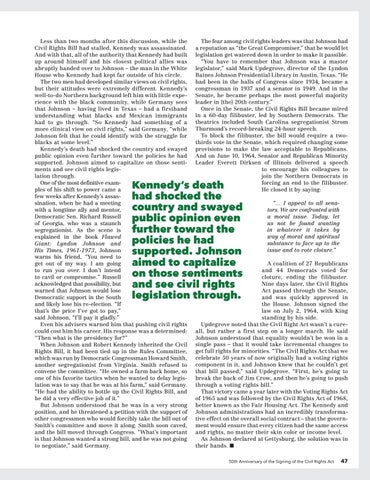Less than two months after this discussion, while the Civil Rights Bill had stalled, Kennedy was assassinated. And with that, all of the authority that Kennedy had built up around himself and his closest political allies was abruptly handed over to Johnson – the man in the White House who Kennedy had kept far outside of his circle. The two men had developed similar views on civil rights, but their attitudes were extremely different. Kennedy’s well-to-do Northern background left him with little experience with the black community, while Germany sees that Johnson – having lived in Texas – had a firsthand understanding what blacks and Mexican immigrants had to go through. “So Kennedy had something of a more clinical view on civil rights,” said Germany, “while Johnson felt that he could identify with the struggle for blacks at some level.” Kennedy’s death had shocked the country and swayed public opinion even further toward the policies he had supported. Johnson aimed to capitalize on those sentiments and see civil rights legislation through. One of the most definitive examples of his shift to power came a few weeks after Kennedy’s assassination, when he had a meeting with a longtime ally and mentor, Democratic Sen. Richard Russell of Georgia, who was a staunch segregationist. As the scene is explained in the book Flawed Giant: Lyndon Johnson and His Times, 1961-1973, Johnson warns his friend, “You need to get out of my way. I am going to run you over. I don’t intend to cavil or compromise.” Russell acknowledged that possibility, but warned that Johnson would lose Democratic support in the South and likely lose his re-election. “If that’s the price I’ve got to pay,” said Johnson, “I’ll pay it gladly.” Even his advisers warned him that pushing civil rights could cost him his career. His response was a determined: “Then what is the presidency for?” When Johnson and Robert Kennedy inherited the Civil Rights Bill, it had been tied up in the Rules Committee, which was run by Democratic Congressman Howard Smith, another segregationist from Virginia. Smith refused to convene the committee. “He owned a farm back home, so one of his favorite tactics when he wanted to delay legislation was to say that he was at his farm,” said Germany. “He had the ability to bottle up the Civil Rights Bill, and he did a very effective job of it.” But Johnson understood that he was in a very strong position, and he threatened a petition with the support of other congressmen who would forcibly take the bill out of Smith’s committee and move it along. Smith soon caved, and the bill moved through Congress. “What’s important is that Johnson wanted a strong bill, and he was not going to negotiate,” said Germany.
The fear among civil rights leaders was that Johnson had a reputation as “the Great Compromiser,” that he would let legislation get watered down in order to make it passible. “You have to remember that Johnson was a master legislator,” said Mark Updegrove, director of the Lyndon Baines Johnson Presidential Library in Austin, Texas. “He had been in the halls of Congress since 1934, became a congressman in 1937 and a senator in 1949. And in the Senate, he became perhaps the most powerful majority leader in [the] 20th century.” Once in the Senate, the Civil Rights Bill became mired in a 60-day filibuster, led by Southern Democrats. The theatrics included South Carolina segregationist Strom Thurmond’s record-breaking 24-hour speech. To block the filibuster, the bill would require a twothirds vote in the Senate, which required changing some provisions to make the law acceptable to Republicans. And on June 10, 1964, Senator and Republican Minority Leader Everett Dirksen of Illinois delivered a speech to encourage his colleagues to join the Northern Democrats in forcing an end to the filibuster. He closed it by saying:
Kennedy’s death had shocked the country and swayed public opinion even further toward the policies he had supported. Johnson aimed to capitalize on those sentiments and see civil rights legislation through.
“… I appeal to all senators. We are confronted with a moral issue. Today, let us not be found wanting in whatever it takes by way of moral and spiritual substance to face up to the issue and to vote cloture.”
A coalition of 27 Republicans and 44 Democrats voted for cloture, ending the filibuster. Nine days later, the Civil Rights Act passed through the Senate, and was quickly approved in the House. Johnson signed the law on July 2, 1964, with King standing by his side. Updegrove noted that the Civil Right Act wasn’t a cureall, but rather a first step on a longer march. He said Johnson understood that equality wouldn’t be won in a single pass – that it would take incremental changes to get full rights for minorities. “The Civil Rights Act that we celebrate 50 years of now originally had a voting rights component in it, and Johnson knew that he couldn’t get that bill passed,” said Updegrove. “First, he’s going to break the back of Jim Crow, and then he’s going to push through a voting rights bill.” That victory came a year later with the Voting Rights Act of 1965 and was followed by the Civil Rights Act of 1968, better known as the Fair Housing Act. The Kennedy and Johnson administrations had an incredibly transformative effect on the overall social contract – that the government would ensure that every citizen had the same access and rights, no matter their skin color or income level. As Johnson declared at Gettysburg, the solution was in their hands. n 50th Anniversary of the Signing of the Civil Rights Act
47
